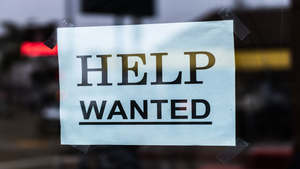S&P 500: 0.94% DOW: 0.78% NASDAQ: 1.11% 10-YR: 1.29%

Last Week on WallStreet - August 7
What Happened
Major indexes muscled out gains last week on encouraging economic data. A positive jobs report gave support to the case for the Fed to consider tapering asset purchases sooner rather than later. Financials (+3.7%), Utilities (+2.3%), and Technology (0.95%) led while Staples (-0.8%) was the only sector in the red.
- Blowout jobs report
- ISM Manufacturing
- ISM Services
- Clarida supports a taper
- Interesting articles from the Waterloo Watercooler

Jeffry Bartash - MarketWatch
US Adds 943,000 Jobs and Unemployment Sinks to 5.4%
The US created a robust 943,000 jobs in July, this vastly exceeded the forecasted 845,000 jobs economists had predicted. This was the largest increase in hiring in nearly a year. The unemployment rate saw a drastic fall to 5.4% which was a new pandemic low that beat expectations of 5.7%. Some government officials state that this number likely underestimated true unemployment slightly, but beating expectations is a positive sign regardless. Moving forward, the percentage of people either working or looking for work rose a tick to 61.7% in July. It is likely we will see this trend continue heading into the fall as schools reopen and people rejoin the labor force.
The key takeaway is that signs are looking strong for the US economy as all aspects of the employment sector are performing well. There are more jobs being created, more people finding jobs, and most importantly, more people looking for jobs. This has been a critique of the economy recently as some people have been hesitant to return to work. If this trend does continue it will help stabilize the economy and hopefully achieve pre-pandemic employment levels sooner rather than later.

Jeffry Bartash - MarketWatch
Broad Shortages still Plague Manufacturers, and Stunt Economic Recovery
US manufacturers are still struggling to cope with broad shortages of supplies and labor that are causing delays in production and holding back the economic recovery, the ISM Manufacturing survey showed. The index dipped to a six-month low of 59.5% in July from 60.6%, which was below Wall Street's forecast. In a potentially good sign, Chairman of the survey Timothy Fiore said price increases may have peaked and companies are starting to resolve supply bottlenecks.
The key takeaway is that manufacturers have plenty of business due to a resurgent economy, but they can’t meet the explosion in pent-up demand owing to persistent shortages tied to the pandemic. These shortages are expected to clear up over time, but it may take a while. The result is likely to be higher prices — inflation — and a somewhat slower economic recovery.

Jeffry Bartash - MarketWatch
Services Saw Explosive Growth in July, but Delta Poses Fresh Threat
Restaurants, hotels, and theme parks are still doing tons of business after the full reopening of the US economy, but they face a new challenge from the delta variant. The ISM Services survey rose to a record 64.1% in July from 60.1% in the prior month. This growth exceeded expectations and can be considered as more than exceptional by survey standards. However, employees are still an issue for the service industry and so are supplies. Businesses are having to pay higher prices for each of these aspects and are passing the costs onto customers. This could cause an elevated level of inflation for the rest of the year.
The key takeaway is that while there is record growth in the service sector, there are still some hurdles that are in the way. The newly found delta variant could pose a threat to reopening as well as higher prices for labor and supplies could be difficult for some businesses. This will be something to watch going forward, but regardless this month's survey result was an extremely positive sign for the overall health of the US economy.

Greg Robb - MarketWatch
Fed’s Clarida Could Support Announcing Slow-Down in Bond Buying Later this Year
The economy is likely to continue to grow so that the labor market heals and inflation averages above 2% for long enough so that by the end of 2022 the US central bank can begin raising interest rates early in 2023, said Federal Reserve Vice Chairman Richard Clarida. He said the Fed would continue to examine tapering “in coming meetings.” He also added that the Fed would provide "advance notice" before making any changes to their asset purchases to avoid any fear in the market like 2013.
The key takeaway is that with the US economy continuing to grow and perform well, the Fed is at least looking at moving away from the lenient, ultra-expansionary monetary policy. They have done a good job of easing this idea onto the mind of American's to ensure not to spook them and the market as a whole. As the Fed continues their meeting schedule it will be something to watrch as it seems tapering is near.

From the Waterloo Watercooler
New York City Mayor Bill de Blasio mandated vaccinations for a range of indoor venues.
Square Inc. has agreed to an all-stock deal worth around $29 billion to acquire Australia’s Afterpay.
Dr. Scott Gottlieb sees COVID vaccine boosters for vulnerable people in US.
Reese Witherspoon's media business, Hello Sunshine, has reportedly been sold at a valuation of $900 million.
New California pig law could lead to a 50% price spike for pork.
Keep track of the Olympics with an official medal count.
From gas savings to tax credits: 7 things to know about Biden’s new electric vehicle and mileage rules
